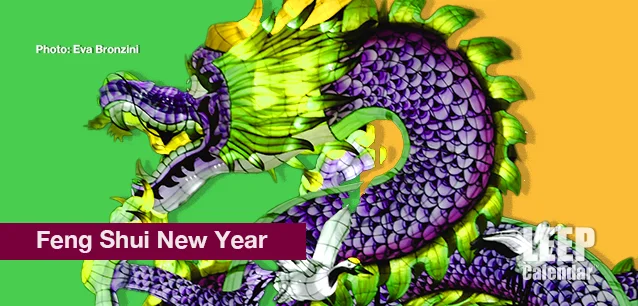 AD
AD
Today is: December 26
Scroll to explore events active on this date.
Additional Events on LEEP
LEEP INK FEATURES

2025 is the Year of...
21 Themes and 'Year of' Events for 2025 PART ONE, THE FIRST 12 Every year, various organizations announce the theme for the year. These themes can focus on causes, such as aesthetics and color tre...

Nuanced November 2024
November is the start of the holiday season in many parts of the world. It is a time for family, football, food, shopping and decorating, particularly in the Christian and Jewish world, leading to Christmas and...

December's Gift
Events in December 2024. Well, we made it to December. December is the holiday season, particularly in Western nations, where Christianity and Judaism are the faiths most common in the nation's past. ...
About the Feng Shui New Year
China Japan & Korea
Ends: Feb 04, 2024
DESCRIPTION:
Feng Shui New Year is the time to reorder your home and surroundings to complement the Chinese New Year and its zodiac. During 2024's Year of the Dragon, spring green and royal yellow are considered particularly auspicious colors.
Feng Shui New Year refers to the observance of the Lunar New Year through the principles of Feng Shui, an ancient Chinese system of aesthetics and geomancy. This practice aims to harmonize individuals with their surrounding environment through the arrangement and orientation of space. Below are some key components that outline the academic understanding of Feng Shui New Year:
Feng Shui Principles: Feng Shui focuses on the balanced flow of Qi, or energy, within a space. During the Lunar New Year, these principles become highly significant as they are believed to affect the coming year's prosperity, health, and happiness.
Preparation: The practice involves thoroughly cleaning and decluttering the living space to remove negative energy and make room for new, positive energy, including carefully positioning furniture, using specific colors, and the placing of symbolic objects.
The Five Elements: Within Feng Shui, the five elements - Wood, Fire, Earth, Metal, and Water - must be balanced. For the New Year, these elements are typically represented through decorations, food, and rituals, aligning with the specific energies of the year.
Yin and Yang: Balancing the dual forces of Yin (feminine, dark, soft) and Yang (masculine, bright, hard) is essential in Feng Shui. During the New Year, this balance is emphasized to ensure harmony in relationships, health, and other aspects of life.
Symbolism: Various symbols are used during Feng Shui New Year to attract specific energies. For example, red wards off evil, and certain animals or objects may be displayed to attract luck, wealth, or other desired outcomes.
Directional Energies: The orientation and direction of objects and structures play a significant role in Feng Shui. During the New Year, adjustments might be made based on the Chinese zodiac animal of the year and the specific energies associated with the changing annual cycles.
Cultural Integration: Feng Shui New Year is a spiritual practice and a cultural phenomenon. It reflects a deep philosophical understanding of nature's balance and human's connection to their environment.
Criticism and Interpretations: Academic study of Feng Shui also includes analysis of different interpretations, criticisms, and the integration of Feng Shui principles in modern urban planning and architecture. Some scholars argue that Feng Shui has evolved into a commercial practice rather than a true spiritual philosophy in some contexts.
In conclusion, the practice of Feng Shui during the Lunar New Year is a multifaceted ritual encompassing aesthetics, philosophy, and spirituality. It is rooted in ancient Chinese cosmology and continues to be a significant aspect of cultural tradition, influencing personal spaces and broader architectural and urban planning concepts.
VIDEOS
SUPPORTING DOCUMENTS
Currently, this event does not have supporting documents.
ADDITIONAL IMAGES
Currently, this event does not have supporting images.
Where would you like to go now?
 AD
AD


/footer-logo.svg)
